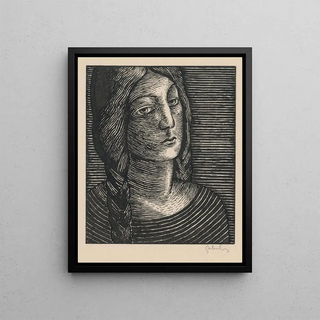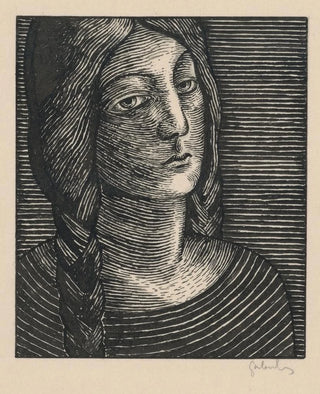Art print | Head of a woman with long braids - Mikuláš Galanda


View from behind

Frame (optional)
The art print Tête de femme aux longues tresses - Mikuláš Galanda evokes an atmosphere of mystery and timeless beauty. This iconic piece, created by the Slovak artist in the 1920s, stands out for its unique approach to female representation. The head of the woman, adorned with long tresses, captures the eye with her enigmatic expression and striking presence. Galanda, through this work, manages to capture not only the form but also the essence of femininity, transcending mere physical features to reach emotional depth. The piece invites introspective contemplation, where each gaze reveals a new nuance of the human soul.
Style and uniqueness of the work
Mikuláš Galanda's style is characterized by a harmonious fusion of tradition and modernity. In Tête de femme aux longues tresses, the artist uses vivid colors and stylized forms to create a composition that is both dynamic and balanced. The tresses, symbols of femininity and culture, are depicted with a delicacy that highlights the artist's craftsmanship. The meticulous details of the face, combined with a bold color palette, give the work an almost dreamlike dimension. The way Galanda plays with light and shadow enhances the three-dimensional aspect of the portrait, immersing the viewer in a universe where reality and dream meet. This stylistic singularity makes Tête de femme aux longues tresses a centerpiece that continues to inspire and amaze.
The artist and his influence
Mikuláš Galanda is a key figure in Slovak art of the 20th century, recognized for his ability to blend influences from folk art and avant-garde movements. Trained at the Academy of Fine Arts in Prague, he developed a personal style that resonates with the social and cultural concerns of his time. Galanda also played a pivotal role in the Slovak artistic movement, encouraging young artists to explore their roots while embracing contemporary innovations. His commitment to art as a means of expression and social reflection has left an enduring legacy

Matte finish

View from behind

Frame (optional)
The art print Tête de femme aux longues tresses - Mikuláš Galanda evokes an atmosphere of mystery and timeless beauty. This iconic piece, created by the Slovak artist in the 1920s, stands out for its unique approach to female representation. The head of the woman, adorned with long tresses, captures the eye with her enigmatic expression and striking presence. Galanda, through this work, manages to capture not only the form but also the essence of femininity, transcending mere physical features to reach emotional depth. The piece invites introspective contemplation, where each gaze reveals a new nuance of the human soul.
Style and uniqueness of the work
Mikuláš Galanda's style is characterized by a harmonious fusion of tradition and modernity. In Tête de femme aux longues tresses, the artist uses vivid colors and stylized forms to create a composition that is both dynamic and balanced. The tresses, symbols of femininity and culture, are depicted with a delicacy that highlights the artist's craftsmanship. The meticulous details of the face, combined with a bold color palette, give the work an almost dreamlike dimension. The way Galanda plays with light and shadow enhances the three-dimensional aspect of the portrait, immersing the viewer in a universe where reality and dream meet. This stylistic singularity makes Tête de femme aux longues tresses a centerpiece that continues to inspire and amaze.
The artist and his influence
Mikuláš Galanda is a key figure in Slovak art of the 20th century, recognized for his ability to blend influences from folk art and avant-garde movements. Trained at the Academy of Fine Arts in Prague, he developed a personal style that resonates with the social and cultural concerns of his time. Galanda also played a pivotal role in the Slovak artistic movement, encouraging young artists to explore their roots while embracing contemporary innovations. His commitment to art as a means of expression and social reflection has left an enduring legacy






